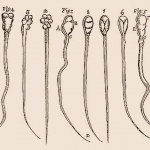Anton van Leeuwenhoek is often credited with designing the earliest of microscopes. With literally a new view of the world, he examined many objects including human sperm described, as you will remember from high school health, as having a "tail, which, when swimming, lashes with a snakelike movement, like eels in water." Turns out he wasn't thinking in all three dimensions.
sperm motility
The U.S. space agency recently launched sperm specimens, from humans and bulls, to the international space station. There, astronauts will conduct experiments on the impact of microgravity on sperm’s motility and function.
Some men would give their right testicle to have access to contraception that doesn't involve pleasure-killing condoms or cringe-inducing surgical snips. Biology, unfortunately, has made targeting contraception at the female reproductive system far easier than targeting the male reproductive system.
The rhythmic whipping of a sperm’s tail is the most basic perception as to how the cell strives to reach the egg for fertilization. But a recent study published in the journal Science reveals a novel mechanism, in which progesterone-dependent sperm cells are primed and activated in the female reproductive tract.


